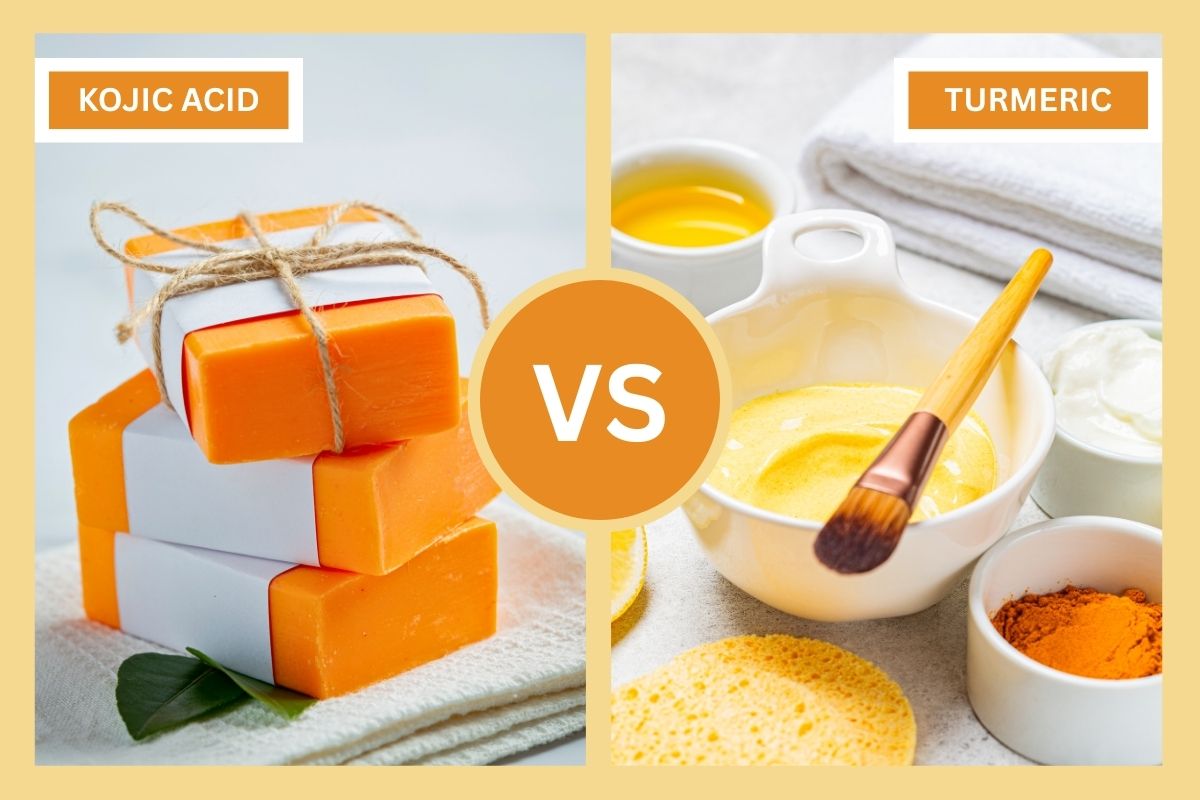
Kojic Acid Vs Turmeric: How To Decide For Your Skin Needs

Published May 21, 2025
Do you want to find the perfect ingredient for brighter, even-toned skin? You’re not alone. When it comes to skincare debates, “kojic acid vs turmeric” is a hot topic—but how do you know which one is right for you? Each offers powerful benefits, but choosing the wrong one could leave your skin undesirable instead of flawless.
In this article, we’ll explore the showdown between kojic acid vs turmeric in skincare. We’ll break down the benefits, how they work, and when to use them. By the end, you’ll know which one deserves a spot in your skincare routine—or if both should.
What Is Kojic Acid?
Kojic acid is a natural byproduct of the fermentation process. It comes from fungi used to make rice wine and soy sauce. What makes it special in skincare? It helps fade dark spots by blocking tyrosinase, an enzyme needed for melanin production.
Here’s how it works:
- Fights hyperpigmentation: Kojic acid slows melanin production. It helps reduce dark spots, melasma, and post-inflammatory hyperpigmentation (PIH).
- Noticeable results over time: With regular use, you may see improvements in a few weeks. More significant changes can appear within 2-3 months.
That said, kojic acid isn’t without its challenges. It carries a higher risk of irritation, particularly for sensitive skin. To avoid discomfort, it’s best to gradually introduce it into your routine.
The Skin Benefits Of Turmeric (Curcumin) Extract
Turmeric, with its vibrant golden hue, is far more than a culinary staple—it’s a skincare powerhouse. It’s packed with curcumin, a compound recognized for its anti-inflammatory and antioxidant benefits. Turmeric naturally promotes healthier skin.
- Soothes inflammation: Are you struggling with redness, acne scars, or post-inflammatory hyperpigmentation (PIH)? Turmeric is a calming ally. It reduces inflammation and helps prevent further pigmentation, leaving your skin more balanced.
- Defends against damage: Turmeric is rich in antioxidants. It safeguards your skin from free radical damage caused by UV rays and pollution, helping prevent premature aging.
- Brightens skin gently: Turmeric is not as potent as kojic acid. However, it inhibits tyrosinase and can gradually improve skin tone. It’s a natural way to achieve a brighter complexion.
Turmeric fades pigmentation and supports skin health. It’s gentle enough for sensitive skin, making it a versatile must-have for any skincare routine.
Common Uses Of Kojic Acid And Turmeric In Skincare
Kojic acid is commonly incorporated into serums, creams, cleansers, and soaps. Serums are popular for their potency and deep skin penetration. Proper storage is key. If not handled properly, kojic acid products oxidize quickly and lose effectiveness.
Turmeric is often used with carefully extracted curcumin in serums, masks, and creams. Professionally made skincare products help avoid issues like staining or inconsistent potency. DIY formulations are not always reliable.

Comparing Turmeric Vs Kojic Acid For Specific Skin Concerns
Hyperpigmentation And Dark Spots
Kojic acid is excellent for stubborn dark spots. It works by reducing melanin production. Turmeric is gentler and targets pigmentation. It also helps with inflammation.
Verdict: Kojic acid works faster for defined, persistent spots. Turmeric is a better fit for widespread pigmentation linked to redness or inflammation.
Melasma And Uneven Skin Tone
Melasma is a stubborn type of hyperpigmentation caused by hormones or sun exposure. Kojic acid reduces melanin overproduction, and turmeric calms inflammation and soothes irritation.
Verdict: Kojic acid is more effective for severe melasma, but combining it with turmeric can help minimize irritation and provide balance.
Acne Scars And Inflammation
Turmeric shines with its powerful anti-inflammatory properties for acne-prone skin. It reduces redness and soothes the skin, gradually fading scars. Kojic acid, though effective at reducing pigmentation, may irritate healing or sensitive skin.
Verdict: Turmeric is gentler and more versatile for addressing acne scars and inflammation.
Skin Brightening And Radiance
Both ingredients excel at enhancing skin brightness but in different ways. Kojic acid focuses on clearing uneven patches for quick results, while turmeric offers antioxidant protection for a sustained, healthy radiance.
Verdict: Kojic acid is the go-to for an instant brightening effect. Turmeric achieves a long-lasting, natural glow.
Kojic Acid Vs Turmeric: Pros And Cons
Efficacy And Results
- Kojic Acid: Consistent use delivers noticeable results faster, often within weeks to a couple of months. However, its effectiveness diminishes without diligent sun protection.
- Turmeric: Works gradually, focusing on overall skin health rather than quick fixes. Patience is essential to see lasting benefits.
Side Effects And Sensitivity
- Kojic Acid: Common side effects include redness, dryness, or peeling, especially if overused or misapplied. Do a patch test and pair with sunscreen to minimize risks.
- Turmeric: Less likely to irritate, but poorly formulated products may leave a temporary yellowish tint on the skin.
Best-Suited Skin Types
- Kojic Acid: Ideal for oily, combination, or normal skin types. It’s less suitable for highly sensitive or eczema-prone skin.
- Turmeric: A versatile option, well-suited for all skin types, particularly dry, sensitive, or inflamed skin.
Compatibility With Other Ingredients
- Both ingredients blend well with hydrators and barrier-strengthening actives like hyaluronic acid and ceramides.
- Avoid combining kojic acid with potent exfoliants (such as AHAs) in the same routine to reduce the risk of irritation.
Choosing The Best Ingredients For Your Skin Type And Goals
For Oily, Acne-Prone Skin
Kojic acid is an excellent choice for targeting pigmentation while managing dark spots. To reduce inflammation and calm the skin, complement it with a soothing cleanser infused with turmeric such as AMVital’s Turmeric Gel Facial Cleanser.
For Dry Or Sensitive Skin
Turmeric is known for its gentle and versatile properties, making it suitable for dry or sensitive skin. For added hydration and nourishment, opt for a cream-based formula.
Daily Brightening Vs Targeted Treatment
For everyday brightening, turmeric-based products are gentle and suitable for regular use. However, if you’re focusing on dark spots or specific pigmentation issues, a concentrated kojic acid serum is more effective.
When To Consult A Dermatologist
Consider seeking expert advice if you:
- Struggle with persistent melasma or pigmentation.
- Experience irritation or discomfort with new skincare products.
- Are exploring advanced treatments like prescription-strength solutions or chemical peels.
By understanding your skin’s needs and goals, you can choose the right ingredients to achieve a healthier, more radiant complexion. If you’re looking for a turmeric-based product tailored for sensitive skin, AMVital’s turmeric skincare line is crafted with soothing, natural ingredients ideal for daily nourishment.
Frequently Asked Questions
Can kojic acid and turmeric be used together?
Yes, but proceed with caution! To avoid irritation, consider alternating their use—apply kojic acid at night and a turmeric-based product in the morning. Always keep an eye out for any signs of sensitivity.
Which is better for long-term use?
Due to its gentle properties, turmeric is typically safer for daily, long-term use. Kojic acid, on the other hand, should be limited to short-term use—ideally 12 to 16 weeks at a time—to minimize the risk of skin sensitivity.
Is turmeric better for sensitive skin than kojic acid?
Turmeric is inherently milder and less likely to cause redness or dryness, making it a better choice for those with sensitive skin.
How long does it take to see results?
Kojic acid shows results in 4 to 8 weeks with regular use. Turmeric takes longer. Noticeable improvement may require several months of consistent application.
Are there natural alternatives to kojic acid and turmeric?
Absolutely! Licorice root and alpha-arbutin can replace kojic acid. Centella asiatica and green tea are natural alternatives to turmeric.

Choosing The Right Glow Getter For Your Skin
When deciding between kojic acid vs turmeric, it ultimately comes down to your skin’s unique needs and tolerance. Kojic acid works quickly to reduce pigmentation. Turmeric takes a gentler, holistic approach. It improves skin health and reduces inflammation.
As with any skincare routine, consistency is key. Pair your ingredients with reliable sun protection. Combine both under professional guidance for the best results. Whether you choose kojic acid, turmeric, or both, radiant skin starts with understanding your skin’s needs. Treat it with care.
Ready to add turmeric to your skincare routine? Discover AMVital’s turmeric-infused line—designed to soothe, brighten, and protect your skin naturally. Whether you want daily radiance or relief from inflammation, AMVital has the glow your skin needs. Visit amvital.com to explore skincare that works with your skin.
Unlock the Power of Turmeric With AMVital Products
Experience the transformative effects of AMVital's meticulously formulated turmeric-infused products. Indulge in the luxurious goodness of our expertly crafted skincare and haircare range. Harness the incredible natural benefits of this golden spice and discover the remarkable power of turmeric. Explore our shop now and unlock radiant, healthier-looking skin and hair. Visit our shop to experience AMVital's finest turmeric products.

This Content Has Been Reviewed For Factual Accuracy
The information presented here has been meticulously checked by our internal experts. To learn more about our rigorous editorial process, you can click here.

About The Author
I'm Corinne Grace, a passionate writer for AMVital.com. I create articles based on sound scientific evidence to help you make healthy decisions. As a nurse, I've been on the front lines, seeing the critical importance of accurate information.
Written by the AMVital Team — sharing turmeric-powered skincare tips to help you glow naturally, every day.
Share



